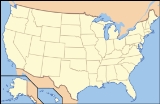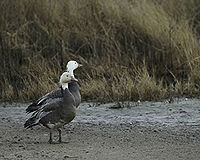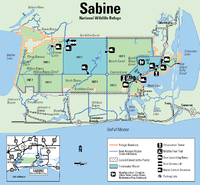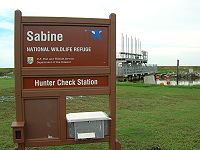
Sabine National Wildlife Refuge
Encyclopedia
Sabine National Wildlife Refuge (established in 1937) is a National Wildlife Refuge
located in Cameron Parish
in southwestern Louisiana
. It is on Louisiana State Route 27
, 8 miles (12.9 km) south of Hackberry
and 12 miles (19.3 km) north of Holly Beach
. The western boundary of the Sabine refuge is Sabine Lake
, the inlet
for Port Arthur, Texas
, while the tip of the eastern end reaches Calcasieu Lake
.
 Sabine is a 124511 acres (504 km²) sanctuary
Sabine is a 124511 acres (504 km²) sanctuary
, the largest coastal marsh refuge on the Gulf Coast of the United States
. It is home to more than 200 species
of bird
s, including duck
s, Great Egret
s, geese
, Neotropic Cormorant
s, raptors
, Snowy Egret
s, wading birds
, and shorebirds. There is also a very large contingent of American Alligator
s, as well as blue crabs, American Mink
, Muskrat
s, Coypu
, North American River Otters, rabbit
s, shrimp
, and turtle
s.
Located at the visitor center is a pamphlet that explains the "Wetland Walkway", a 1.5 miles (2.4 km) nature trail made from concrete, a portion of which is a wooden boardwalk, located 4 miles (6.4 km) south of the refuge headquarters (HQ). It includes an observation tower, and it has 15 knowledge stations, to acquaint and educate, the visitor with the Gulf Coast marsh
. There is a second natural trail, "Blue Goose Trail", north of the camp HQ, that is a 1 miles (1.6 km) round trip with a scenic overlook.
Petroleum
exploration is allowed on the refuge. There was an oil spill at one of the well sites in Sabine during the winter
of 2002-2003. Most of the spill was cleaned up by burning the oil.
 Sabine NWR was in the direct path of Hurricane Rita
Sabine NWR was in the direct path of Hurricane Rita
on September 24, 2005 and as a result the National Wildlife Refuge is currently closed to all public uses because of damages sustained during the hurricane.
All of the office buildings, visitor center and maintenance shops were damaged beyond repair and have been removed. There are three remaining structures at the Sabine NWR headquarters area that will be repaired: boathouse, a block storage building and a tin-covered storage shed.
Refuge recreational areas along Highway 27
received varying amounts of damage to bridges, piers, observation towers, boardwalks, restroom facilities, fences, and parking lots. These facilities need to be repaired before the areas can be re-opened for public use. Refuge staff is working with state and local partners, contractors, and other federal agencies to have these repairs completed.
West of Highway 27, Sabine refuge canals and marshes were severely affected by storm wind and water. Approximately 32000 acres (129.5 km²) of refuge marshes, levees, and canals were damaged. Canals and marshes are clogged with seven million cubic meters of debris from off shore rigs and coastal communities. There are both physical and chemical hazards present throughout the refuge, many of which have settled below the marsh and water surfaces. Tanks and barrels containing hazardous liquids and gases have the potential to explode or break down and release toxins into the environment. Over 1,400 hazardous material containers have been identified and are estimated to contain between 115,000 and 350,000 gallons of hazardous liquids and gases.

National Wildlife Refuge
National Wildlife Refuge is a designation for certain protected areas of the United States managed by the United States Fish and Wildlife Service. The National Wildlife Refuge System is the world's premiere system of public lands and waters set aside to conserve America's fish, wildlife and plants...
located in Cameron Parish
Cameron Parish, Louisiana
Cameron Parish is the parish with the most land area in the U.S. state of Louisiana. The parish seat is Cameron and as of 2010, the population was 6,839...
in southwestern Louisiana
Louisiana
Louisiana is a state located in the southern region of the United States of America. Its capital is Baton Rouge and largest city is New Orleans. Louisiana is the only state in the U.S. with political subdivisions termed parishes, which are local governments equivalent to counties...
. It is on Louisiana State Route 27
Louisiana Highway 27
Louisiana Highway 27 is a state highway that serves Beauregard Parish, Calcasieu Parish, and Cameron Parish. It spans as a north south road with running west to east...
, 8 miles (12.9 km) south of Hackberry
Hackberry, Louisiana
Hackberry is a census-designated place in Cameron Parish, Louisiana, United States. The population was 1,699 at the 2000 census. It is part of the Lake Charles Metropolitan Statistical Area.-Geography:Hackberry is located at ....
and 12 miles (19.3 km) north of Holly Beach
Holly Beach, Louisiana
Holly Beach , also known as the "Cajun Riviera" , is a coastal community in unincorporated Cameron Parish, Louisiana, United States.Known for crabbing and a drive on the beach, this small Southwest Louisiana community mainly consisted of beach-front cabins called "camps" which, due to the threat of...
. The western boundary of the Sabine refuge is Sabine Lake
Sabine Lake
200px | thumb | Sabine lake as seen from outer space.Sabine Lake is a salt water estuary on the Texas-Louisiana border. The lake, some long and wide, is formed by the confluence of the Neches River and Sabine River. Through its tidal outlet long, Sabine Pass, Sabine Lake drains some of Texas...
, the inlet
Inlet
An inlet is a narrow body of water between islands or leading inland from a larger body of water, often leading to an enclosed body of water, such as a sound, bay, lagoon or marsh. In sea coasts an inlet usually refers to the actual connection between a bay and the ocean and is often called an...
for Port Arthur, Texas
Port Arthur, Texas
-Demographics:As of the 2000 census, there were 57,755 people, 21,839 households, and 14,675 families residing in the city. The population density was 696.5 people per square mile . There were 24,713 housing units at an average density of 298.0 per square mile...
, while the tip of the eastern end reaches Calcasieu Lake
Calcasieu Lake
Calcasieu Lake is a brackish lake located in southwest Louisiana, United States, located mostly within Cameron Parish. The lake is paralleled on its west shore by Louisiana Highway 27 and is located about 17 miles south of Lake Charles, Louisiana....
.
Wildlife and habitat

Sanctuary
A sanctuary is any place of safety. They may be categorized into human and non-human .- Religious sanctuary :A religious sanctuary can be a sacred place , or a consecrated area of a church or temple around its tabernacle or altar.- Sanctuary as a sacred place :#Sanctuary as a sacred place:#:In...
, the largest coastal marsh refuge on the Gulf Coast of the United States
Gulf Coast of the United States
The Gulf Coast of the United States, sometimes referred to as the Gulf South, South Coast, or 3rd Coast, comprises the coasts of American states that are on the Gulf of Mexico, which includes Texas, Louisiana, Mississippi, Alabama, and Florida and are known as the Gulf States...
. It is home to more than 200 species
Species
In biology, a species is one of the basic units of biological classification and a taxonomic rank. A species is often defined as a group of organisms capable of interbreeding and producing fertile offspring. While in many cases this definition is adequate, more precise or differing measures are...
of bird
Bird
Birds are feathered, winged, bipedal, endothermic , egg-laying, vertebrate animals. Around 10,000 living species and 188 families makes them the most speciose class of tetrapod vertebrates. They inhabit ecosystems across the globe, from the Arctic to the Antarctic. Extant birds range in size from...
s, including duck
Duck
Duck is the common name for a large number of species in the Anatidae family of birds, which also includes swans and geese. The ducks are divided among several subfamilies in the Anatidae family; they do not represent a monophyletic group but a form taxon, since swans and geese are not considered...
s, Great Egret
Great Egret
The Great Egret , also known as the Great White Egret or Common Egret, White Heron, or Great White Heron, is a large, widely-distributed egret. Distributed across most of the tropical and warmer temperate regions of the world, in southern Europe it is rather localized...
s, geese
Goose
The word goose is the English name for a group of waterfowl, belonging to the family Anatidae. This family also includes swans, most of which are larger than true geese, and ducks, which are smaller....
, Neotropic Cormorant
Neotropic Cormorant
The Neotropic Cormorant or Olivaceous Cormorant is a medium-sized cormorant found throughout the American tropics and subtropics, from the middle Rio Grande and the Gulf and Californian coasts of the USA south through Mexico and Central America to southern South America. It also breeds on the...
s, raptors
Bird of prey
Birds of prey are birds that hunt for food primarily on the wing, using their keen senses, especially vision. They are defined as birds that primarily hunt vertebrates, including other birds. Their talons and beaks tend to be relatively large, powerful and adapted for tearing and/or piercing flesh....
, Snowy Egret
Snowy Egret
The Snowy Egret is a small white heron. It is the American counterpart to the very similar Old World Little Egret, which has established a foothold in the Bahamas....
s, wading birds
Wader
Waders, called shorebirds in North America , are members of the order Charadriiformes, excluding the more marine web-footed seabird groups. The latter are the skuas , gulls , terns , skimmers , and auks...
, and shorebirds. There is also a very large contingent of American Alligator
American Alligator
The American alligator , sometimes referred to colloquially as a gator, is a reptile endemic only to the Southeastern United States. It is one of the two living species of alligator, in the genus Alligator, within the family Alligatoridae...
s, as well as blue crabs, American Mink
American Mink
The American mink is a semi-aquatic species of Mustelid native to North America, though human intervention has expanded its range to many parts of Europe and South America. Because of this, it is classed as Least Concern by the IUCN. Since the extinction of the sea mink, the American mink is the...
, Muskrat
Muskrat
The muskrat , the only species in genus Ondatra, is a medium-sized semi-aquatic rodent native to North America, and introduced in parts of Europe, Asia, and South America. The muskrat is found in wetlands and is a very successful animal over a wide range of climates and habitats...
s, Coypu
Coypu
The coypu , , also known as the river rat, and nutria, is a large, herbivorous, semiaquatic rodent and the only member of the family Myocastoridae. Originally native to subtropical and temperate South America, it has since been introduced to North America, Europe, Asia, and Africa, primarily by...
, North American River Otters, rabbit
Rabbit
Rabbits are small mammals in the family Leporidae of the order Lagomorpha, found in several parts of the world...
s, shrimp
Shrimp
Shrimp are swimming, decapod crustaceans classified in the infraorder Caridea, found widely around the world in both fresh and salt water. Adult shrimp are filter feeding benthic animals living close to the bottom. They can live in schools and can swim rapidly backwards. Shrimp are an important...
, and turtle
Turtle
Turtles are reptiles of the order Testudines , characterised by a special bony or cartilaginous shell developed from their ribs that acts as a shield...
s.
Located at the visitor center is a pamphlet that explains the "Wetland Walkway", a 1.5 miles (2.4 km) nature trail made from concrete, a portion of which is a wooden boardwalk, located 4 miles (6.4 km) south of the refuge headquarters (HQ). It includes an observation tower, and it has 15 knowledge stations, to acquaint and educate, the visitor with the Gulf Coast marsh
Marsh
In geography, a marsh, or morass, is a type of wetland that is subject to frequent or continuous flood. Typically the water is shallow and features grasses, rushes, reeds, typhas, sedges, other herbaceous plants, and moss....
. There is a second natural trail, "Blue Goose Trail", north of the camp HQ, that is a 1 miles (1.6 km) round trip with a scenic overlook.
Petroleum
Petroleum
Petroleum or crude oil is a naturally occurring, flammable liquid consisting of a complex mixture of hydrocarbons of various molecular weights and other liquid organic compounds, that are found in geologic formations beneath the Earth's surface. Petroleum is recovered mostly through oil drilling...
exploration is allowed on the refuge. There was an oil spill at one of the well sites in Sabine during the winter
Winter
Winter is the coldest season of the year in temperate climates, between autumn and spring. At the winter solstice, the days are shortest and the nights are longest, with days lengthening as the season progresses after the solstice.-Meteorology:...
of 2002-2003. Most of the spill was cleaned up by burning the oil.
Hurricane damage

Hurricane Rita
Hurricane Rita was the fourth-most intense Atlantic hurricane ever recorded and the most intense tropical cyclone ever observed in the Gulf of Mexico. Rita caused $11.3 billion in damage on the U.S. Gulf Coast in September 2005...
on September 24, 2005 and as a result the National Wildlife Refuge is currently closed to all public uses because of damages sustained during the hurricane.
All of the office buildings, visitor center and maintenance shops were damaged beyond repair and have been removed. There are three remaining structures at the Sabine NWR headquarters area that will be repaired: boathouse, a block storage building and a tin-covered storage shed.
Refuge recreational areas along Highway 27
Louisiana Highway 27
Louisiana Highway 27 is a state highway that serves Beauregard Parish, Calcasieu Parish, and Cameron Parish. It spans as a north south road with running west to east...
received varying amounts of damage to bridges, piers, observation towers, boardwalks, restroom facilities, fences, and parking lots. These facilities need to be repaired before the areas can be re-opened for public use. Refuge staff is working with state and local partners, contractors, and other federal agencies to have these repairs completed.
West of Highway 27, Sabine refuge canals and marshes were severely affected by storm wind and water. Approximately 32000 acres (129.5 km²) of refuge marshes, levees, and canals were damaged. Canals and marshes are clogged with seven million cubic meters of debris from off shore rigs and coastal communities. There are both physical and chemical hazards present throughout the refuge, many of which have settled below the marsh and water surfaces. Tanks and barrels containing hazardous liquids and gases have the potential to explode or break down and release toxins into the environment. Over 1,400 hazardous material containers have been identified and are estimated to contain between 115,000 and 350,000 gallons of hazardous liquids and gases.
Stats

- Location: 29°54′N 93°32′W
- Elevation: 10 feet (3 m; avg)
- Area:
- Water: 39,844 acres (161 km2)
- Grassland/herbaceous/marsh: 84,667 acres (343 km2)
- Annual visitors: 300,000 (approximately)
See also
- List of National Wildlife Refuges: Louisiana

